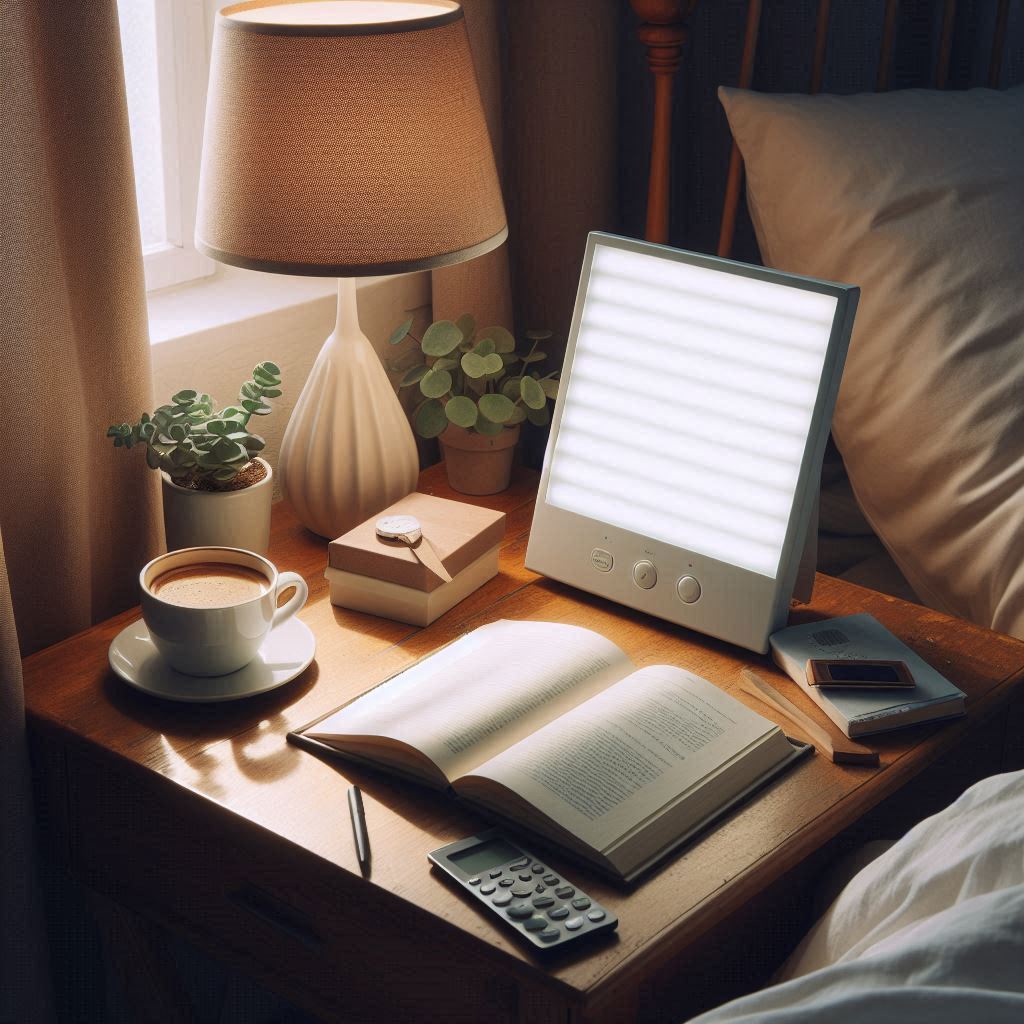 I first came across light therapy during a period in my life when the gray skies of winter seemed to cast a shadow over everything, including my mood—like many, the short, dark days had a noticeable effect on my well-being. This is where light therapy enters the picture. It’s a form of treatment that has gained attention for its role in addressing seasonal affective disorder (SAD) and other forms of depression.
I first came across light therapy during a period in my life when the gray skies of winter seemed to cast a shadow over everything, including my mood—like many, the short, dark days had a noticeable effect on my well-being. This is where light therapy enters the picture. It’s a form of treatment that has gained attention for its role in addressing seasonal affective disorder (SAD) and other forms of depression.
The concept of light therapy is straightforward. It involves sitting near a device called a light therapy box, which emits a bright light that mimics natural outdoor light. The idea is to expose yourself to this light daily, especially during the months when sunlight is scarce. This daily ritual is believed to cause a chemical change in the brain that lifts your mood and eases other symptoms of depression.
Light therapy’s roots can be traced back to the early 1980s when researchers first explored the relationship between light exposure and circadian rhythms. The medical community has since recognized the treatment for its potential to regulate sleep patterns, boost mood, and improve the overall quality of life for individuals facing depression, especially those affected by seasonal changes.
At the heart of light therapy is its focus on exposure to certain wavelengths of light, which are thought to trigger the brain’s release of serotonin. This neurotransmitter contributes to feelings of happiness and well-being. Exposure to light first thing in the morning is typically recommended as it helps reset your internal clock, which can be especially beneficial for individuals whose circadian rhythms are disrupted.
The Benefits of Using Light Therapy at Home

Using light therapy to combat depression doesn’t mean you are locked into frequent clinical visits. One of the significant advantages is the option to use it right in the comfort of your home. Home-based treatment offers a range of benefits that can be especially appealing if you’re managing a busy schedule or if accessibility is a challenge.
One notable benefit is the cost savings over time. While the initial purchase of a light therapy device might seem substantial, it pales in comparison to the cumulative cost of in-office treatment sessions. Investing in a home device means you have the tools at your disposal whenever you need them, without additional costs.
Moreover, the luxury of not scheduling appointments or traveling to a clinic can’t be overstated. You have the freedom to conduct your light therapy sessions at the time that works best for you, whether that’s early in the morning or during a lunch break. This flexibility is not just convenient; it can also lead to more consistent use, which is crucial for obtaining the best results from light therapy.
Finally, being able to control your environment during treatment enhances relaxation and comfort. You can create a calming space at home where you feel at ease, thereby potentially increasing the therapy’s effectiveness.
Choosing the Right Light Therapy Device for Home Use
Navigating the market of light therapy devices can be overwhelming. With various products touting different benefits, it’s crucial to discern which features matter in your journey toward improved mental health.
Let’s begin with light intensity. For light therapy to be effective, a device must emit a certain brightness level, typically measured in lux. Most experts agree that a device offering 10,000 lux, which mimics a bright, sunny day, is ideal for therapeutic use. Duration of exposure is also pivotal, as most research supports sessions ranging from 20 to 30 minutes each day.
Next, consider the type of light. Devices producing full-spectrum light without UV rays are often recommended because they safely replicate natural sunlight. Remember to look for a device with minimal UV radiation to protect your skin and eyes.
Furthermore, size and design factor into your decision. While a larger lightbox allows for more flexibility in movement during sessions, a smaller unit might be more convenient for those with limited space or who require portability.
Price and durability are other considerations. While staying budget-conscious is important, investing in a quality device may be more cost-effective over time. A robust, well-built device typically translates to longevity and consistent performance.
Lastly, opt for devices from established brands with positive user reviews and proper certification. Evidence of clinical trials or endorsements by mental health professionals can be a good indicator of efficacy.
With your ideal light therapy unit in hand, you’re ready to set up a space that encourages consistent use. The next step is to make this therapy work seamlessly with your daily life, which I’ll cover in the following section.
✨👆Find the Perfect Light Therapy Lamps for a Brighter Mood!👆🌟
Best Practices for Home Light Therapy Sessions
Establishing a routine is crucial. Consistency is key in light therapy, as it is with most treatments aimed at improving mental health. Decide on a specific time each day for your light therapy, aligning it with your natural wake-up time to mimic the sunrise if possible.
Your environment matters. Set up your light therapy device in a comfortable, private space. Ensure that the light faces you, ideally at eye level, while avoiding direct eye contact, to maximize exposure without causing discomfort.

Multitasking is permissible. Contrary to some misconceptions, you don’t have to sit still and stare at the light. Feel free to engage in other activities, such as reading or eating breakfast, as long as the light source remains properly positioned.
Don’t overdo it. Begin with the recommended time, often around 20-30 minutes, and adjust as necessary based on your response to the treatment and any guidance from your healthcare provider. More isn’t always better, especially if you experience discomfort.
Bear with the process. It might take a few days or even weeks to notice improvements in your mood. During this period, it’s important to maintain consistency and not lose hope if immediate results aren’t apparent.
Keep a journal. Documenting your experience can help identify patterns and progress. Note your mood, energy levels, and any side effects before and after sessions.
Anticipate transitions. As you move on to monitoring your progress in the next section, remember that light therapy isn’t an instant cure, but rather a beneficial component of a broader strategy to enhance your wellbeing.
Monitoring Your Progress and Adjusting Treatment

If you’re venturing into the world of light therapy at home, one of the most critical steps is to monitor your reactions carefully. Just as with any other treatment for depression, individual experiences will vary. It’s important to keep an eye on how you’re feeling day-to-day and take note of any changes, both positive and negative.
Start by creating a simple log or journal to record your moods and energy levels each day. This doesn’t have to be elaborate – a few notes about your general well-being can be incredibly telling over time. Noticing patterns in your mood can signal when to adjust the intensity or duration of your light therapy sessions.
Remember, adjusting treatment is normal and often necessary. If you’re not seeing the improvements you anticipated, increasing the duration of your sessions may help. On the other hand, if the light feels too intense or you’re experiencing discomfort, it’s perfectly okay to reduce the time or sit a bit further away from the device.
I cannot stress enough the importance of communication with healthcare providers, especially if you’re managing clinical depression. They can offer expert advice on adjustment strategies and ensure that your treatment aligns with your overall health plan.
Ultimately, managing your mental health requires flexibility and responsiveness to your changing needs. As you continue using light therapy, you’ll become adept at recognizing what works best for your unique situation.
Safeguarding Your Mental Health: Beyond Light Therapy
While light therapy can play a key role in managing depressive symptoms, it’s crucial to remember it’s one piece of a larger mental health puzzle. Keeping up with overall well-being demands more than a singular approach.
No treatment is a silver bullet, and light therapy is no exception. Embracing a variety of lifestyle changes, such as regular exercise and a balanced diet, can significantly bolster the effects of light therapy. Healthy habits contribute to better treatment outcomes and more stable moods over time.
This is not to overshadow the value of professional guidance. Mental health is complex, and adding complementary strategies should often be done with the input of a healthcare provider to ensure the best possible results.
In situations where light therapy alone isn’t yielding the improvements hoped for, it might be time to consider additional treatments. Cognitive-behavioral therapy, medication, or a combination of other therapeutic approaches could be necessary.
Your health journey is unique, and your treatment plan should be too. Keeping an open dialogue with your mental health professional and staying informed on your options can empower you to make the best choices for your circumstances.
References:
Harvard Health Publishing – Light Therapy for Depression: https://www.health.harvard.edu/
Mayo Clinic – Light Therapy: https://www.mayoclinic.org/
National Institute of Mental Health – Seasonal Affective Disorder: https://www.nimh.nih.gov/health/


